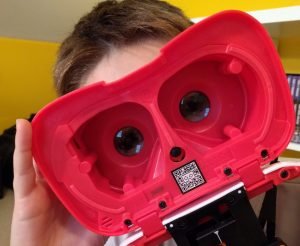But VR didn't quite make the cut for our Christmas wish lists this year, so the kids and I decided to dust off our Google Cardboard headsets this weekend so that we could get a taste of it anyway.
Google Cardboard was introduced at the Google I/O conference in 2014, a product of Google's famous (and now, almost non-existent) 20% innovation time. When you hear the name "Cardboard," you most often think of the simple VR headsets, but the technology consists of several building blocks:
Viewer: Cardboard gets its name from the inexpensive cardboard phone holders that are an integral part of the experience. You can create your own headset with the free plans available here, but you'll likely have a hard time sourcing the lenses, which are the most important part of the build, not to mention magnets, Velcro, and capacitive tape. For that reason, picking up an inexpensive pair from the Google Store is the best bet. $15 will get you one pair, and $25 will get you two pairs. We picked up several viewers in 2015, including ones from Knox Labs, I am Cardboard, Go4D, and Viewmaster.
Software: Developers use the Cardboard SDK to create compatible apps. There are SDK's available for Android, iOS, and Unity; and Unreal Engine natively supports Google VR. The SDK takes care of some of the trickier development aspects, including lens distortion correction, stereoscopic rendering, spatial audio, and head tracking. Users will use Cardboard-enabled apps to play and experience VR. Google's own Cardboard app is a good place to start, as it organizes the experience and catalogs some apps you might want to try.
Phone: The hardware to run apps is supplied by your smartphone. We played with an iPhone 5S, a Nexus 5X, and a Nexus 6P. The iPhone was a bit too small to be effective in the viewers. The Go4D had a hard time holding the phone, and getting screen touches working was troublesome in several viewers. The 6P provided the best experience, due to both the high-resolution display, and the top and bottom speakers, which really exercised the spatial audio capabilities enabled by the SDK.
One of the big issues to overcome in VR is motion sickness. When the visual environment doesn't track perfectly to your head movements, motion sickness is an inevitable result. Google's no-tech solution to this is forbidding head straps on approved viewers, and keeping the fabrication relatively rough and uncomfortable. That is, they combat the motion sickness issue by ensuring that you can't use the viewer for too long in one sitting. The reality is that combating the motion sickness issue requires some serious algorithms and computing power, which is one of the reasons for the steep price tag on most real VR solutions.
Another related issue with Cardboard apps is that they're just not interactive enough, and due to the aforementioned motion sickness dilemma, they really can't be. True interactivity requires that you can move around in the environment, and Cardboard limits you to looking around, rather than moving around. You'll notice this in many exploration-style games when the game requires you to stand in designated spaces before you can look around, or where you're "beamed" from location to location, instead of moving from location to location. Again, the algorithms required to enable this are out of reach for Cardboard. The result is that the experience is flat in many of the games compatible with the viewers. Proton Pulse is my favorite Cardboard game, and it's a remake of a classic online game (though I can't recall the original name), but it's slower and is split into levels. My biggest gripe with Cardboard is that your field of vision is artificially limited due to the lenses, which requires much more head movement than I feel is realistic for these experiences. Crossy Road and Gold Miner were absolutely tedious.

Where Cardboard does shine is 360-degree viewing experiences. You can use Cardboard Camera to capture your own photos for VR viewing, there are apps for converting your own videos so they are Cardboard-compatible (my son loved seeing himself on the BMX track via Cardboard), there are many apps for viewing and touring landmarks and points of interest around the world, and there are many apps for experiencing things in VR, e.g. roller coaster rides, base jumping, surfing. The Viewmaster Cardboard viewer contained several discs with great content, and some other good apps to try are Sites in VR and Orbulus.
So while Cardboard isn't true virtual reality, it will whet your appetite for it, and I think that's the intent behind Cardboard. VR shows a lot of promise not just for gaming, but also as a computing and communication platform. But to make it profitable, it needs to be more mainstream, and these entry-level viewers enable just that. Google Cardboard is an inexpensive and fun entry into the world of VR. Maybe next year it will make it to the top of our Christmas wish lists.
Update 2021: we ended up getting the Playstation 4 Pro and PlayStation VR. We're a Playstation household and we had previous good experiences with the PS3 and PS Move product, so it was a familiar choice for us.
Ihave heard there are troubles of more than one kind. Some come from ahead, and some come from behind. But I've brought a big bat. I'm all ready, you see. Now my troubles are going to have troubles with me!
- Dr. Seuss

Hi, Shaun here. No, not the soccer player. And not the children's performer. Just me, a 40-something father of two, residing in Raleigh, NC, where the summer heat has me questioning my life choices.
I try lots of things. I'm okay at some of them. My hobby is collecting hobbies. I drink a lot of coffee. I'm susceptible to ear worms. I throw myself into the things I love. I can't wait for the weekend.